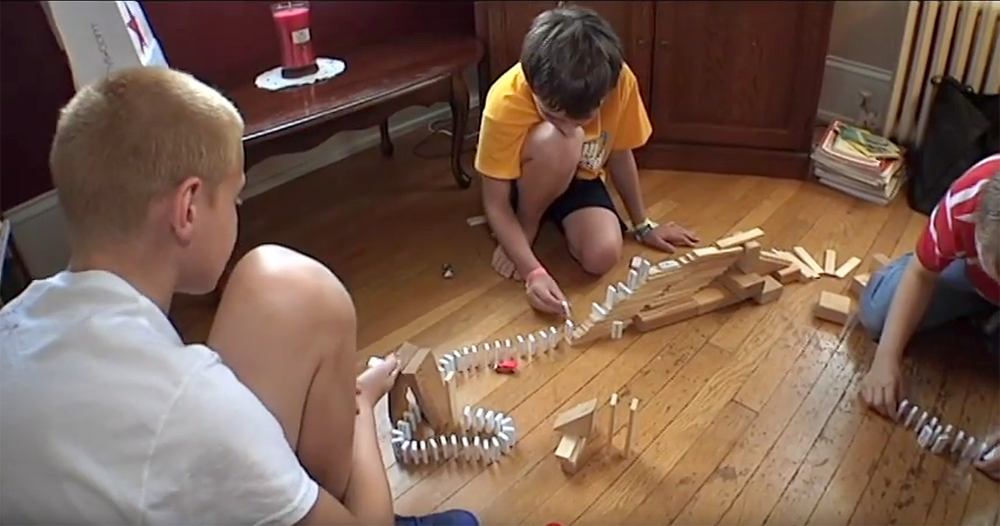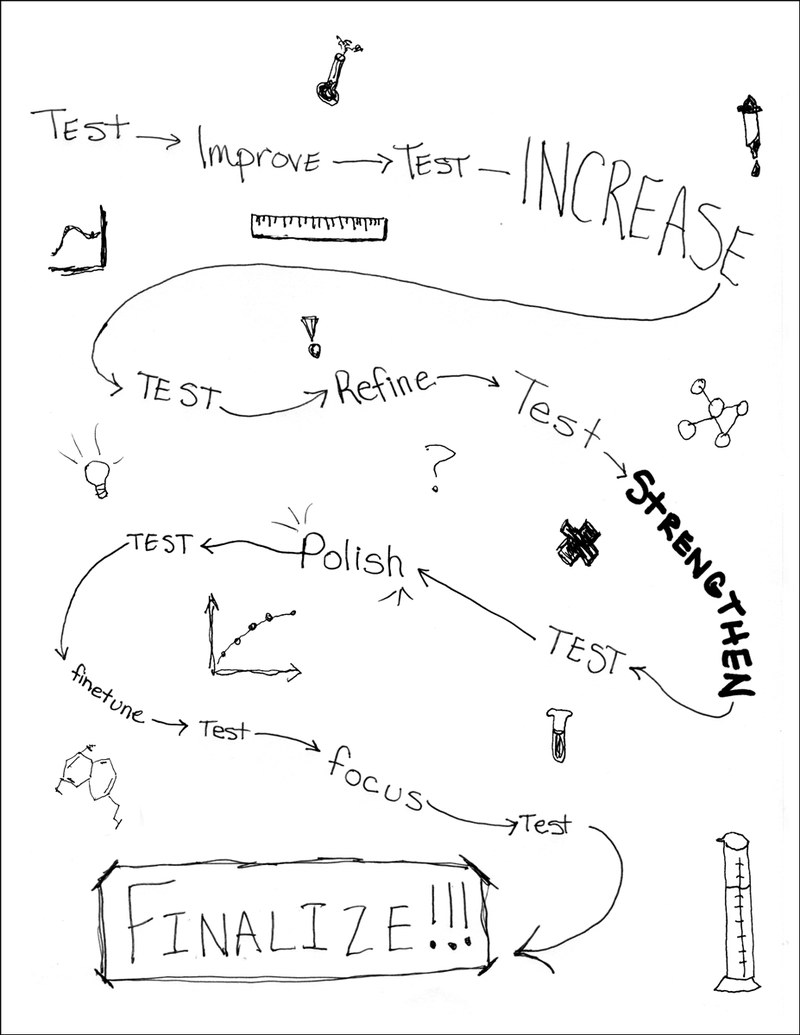Posted: January 31, 2025
The name Rube Goldberg has become synonymous with the building of crazy contraptions. How can this kind of wacky thinking inspire early childhood classroom experiences?

Three older children are on the floor constructing a complex dominoes path together.
Rube Goldberg machines operated on chain reaction principles. They used materials in eccentric combinations to accomplish everyday tasks. Children of all ages can benefit from Goldberg-style cause-and-effect experimentation. The providers who encourage them can expect great levels of laughter, creativity, and out-of-the-box thinking!
Who was Rube Goldberg?
Rube Goldberg (1883 - 1970) was a Pulitzer-prize-winning cartoonist and satirist who drew zany invention cartoons. He had a degree in engineering from University of California--Berkeley, and is the only person listed in the Merriam-Webster Dictionary as an adjective! His "Crazy Inventions" series starred Professor Lucifer Gorgonzola Butts who created elaborate contraptions to accomplish very simple tasks. Cartoon drawings of the automatic weight-reducing machine, a simple fly swatter, and others have inspired generations of chain reaction inventions in his name (The Rube Goldberg Institute for Innovation & Creativity, n.d.).
What is a Rube Goldberg contraption?
Adam Sadowsky describes a Rube Goldberg contraption as an "over-engineered piece of machinery that accomplishes a relatively simple task" (Sadowsky, 2010, 1:18).
Rube Goldberg-like inventions use a chain reaction or cause-and-effect principles to accomplish an end goal.
Part-whole connections
When children create chain reaction contraptions, they explore many concepts like:
- Basic physics and simple machines
- Design concepts—balance, symmetry
- Cause and effect (if-then thinking)
- Part-whole thinking—composition and decomposition, divergent thinking-convergent thinking
- Repurposing of materials—maker-centered learning, tinkering
- Process thinking (What else? What next? What if?)
- Eye-hand coordination
- Measuring
- Collaboration and negotiation of ideas
- Organizing and planning
- Persistence
Start small
Encourage young inventors to think in sections with a cause and effect for each section. With inexperienced children, chaining together two sections of causes and effects with a bit of movement may be enough. Success with a small chain encourages further inventing with more elaborate connections. These types of experiments can be set up for toddlers to enjoy. It might be something as simple as rolling a ball down a ramp in the classroom. At the bottom, the ball knocks over a stack of cardboard blocks, and then a falling block bumps a tap bell. Preschoolers can be part of the construction and imagination team. Children might discover as they create and connect that a shape like a triangle has strength or that a flimsy material can become stronger if it is folded or rolled. They learn that small components contribute in important ways. They learn the importance of testing one section of the chain reaction at a time in order to make sure it works. When children conduct tests or trials, they are acting like young engineers.

Test and improve
Providers should expect progress, not perfection, as children brainstorm and then build their chain reactions. Encourage testing of each section as the creating progresses. Trial runs or preliminary models allow children to measure, observe, collect data, and use tools; to design, develop, and implement solutions; to evaluate ideas; and to problem solve. These are all valuable STEM skills. Professionals run trials or tests all the time, and use words like:
- Alpha test
- Beta test
- Clinical trial
- Draft
- Experimental group vs control group
- Pilot
- Prototype
- Rough copy
- Run
- Straw man proposal
- Test recipe
- Working model
The children will simply work on their chain reaction inventions, but as educators, the staff knows that these experiences are nurturing important "21st-century" abilities:
- View failure as an opportunity to learn
- Assess own ideas in order to improve
- Understand how parts impact one another
- Deal positively with praise, setbacks, and criticism
- Solve new problems in both expected and innovative ways
- Realize that creativity and innovation are long-term, cyclical processes of "small successes and frequent mistakes"
(Battelle for Kids, 2019)
Provider strategies
- Use spatial language--words like over, under, next to, through. Children who are exposed to more spatial language during their preschool years outperform their peers in spatial tests years later.
- Don't rush in and fix a design idea when it doesn't work the way the child expected. Instead, help them to observe, see what happened, what they thought would happen and encourage them to adjust it and try again. "Support, rather than intervention, is a mark of respect for the child" (Christie, 2015, para. 2).
- Have an ample supply of open-ended materials and loose parts. Get families engaged by asking them to send in recyclables to be part of the building supplies. Provide lots of connecting supplies--wire or twist ties, masking tape, yarn, tubes.
- Provide clipboards, pencils, and paper to sketch a plan or ideas. Children as young as 3 years of age can make a connection between a simple map or diagram and the physical world.
- Invite engineers from your early childhood families or from the community to come and mentor the young chain reaction builders.
- Take video clips of the planning, constructing, and test runs to document the learning.
Tool is not a toy
As children take apart things and repurpose parts, it's a perfect time to learn about the safe, proper use of tools. Learning the names of tools and how to use things like screwdrivers, pliers, wire cutters, scissors, tape measures, and tweezers are important life skills. The building and tinkering during the creation of a Rube Goldberg contraption provides an appropriate platform to demonstrate those skills in a meaningful way. Rebecca Grabman, MAKESHOP Manager, Children's Museum of Pittsburgh, explains that children sometimes need to be told that they don't stick tools into sockets, puncture anything, or use them as weapons. They need to be coached about trying not to break pieces as they disassemble machines or toys for use in other projects. If children misuse a tool, they are not allowed to use the tool until they are retrained on the safety procedures and demonstrate "good judgment" because a tool is not a toy (R. Grabman, personal communication, November 20, 2015).
Lasting life lessons
Cause and effect—why experience it? Experiencing and understanding cause and effect is not only an academic lesson, but also a life lesson: Each action or effort brings a result. When children experiment with chain reactions, they learn at a very basic level that "I have power and can affect the future by my choices and decisions." They nurture an internal locus of control. That's an investment that every early childhood professional will find worth making!
Want to think about these ideas more?
Check out these web documents:
Check out these videos:
- Click2SciencePD—Constructing Explanations
- The Wonder of Science—CCC2: Cause and Effect
- C2S Testing
- C2S Modeling Science and Engineering
- How to Engineer a Viral Music Video
Check out these Better Kid Care Resources:
- On Demand course available in English and Spanish: Click2Science: Testing-Testing-1-2-3
- I Think I Can…I Think I Can… (PDF)
- Loose Parts: What does this mean?
Check out another kind of building challenge:
References
Christie, (2015, Dec. 15). Respectful Care of Infants. ExchangeEveryDay.
The Rube Goldberg Institute for Innovation & Creativity. (n.d.). A Cultural Icon. Retrieved January 2025, from https://www.rubegoldberg.org/all-about-rube/a-cultural-icon/
Sadowsky, (2010, April). How to Engineer a Viral Music Video. TED.

